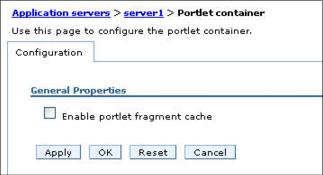Portlet caching
Portlet caching is essentially the same as servlet caching. There are new request components available and some servlet request components are unavailable.
Note that there are interactions between enabling portlet and servlet caching such that if portlet caching gets enabled, servlet caching does, too.

Figure 6-1 Enabling portlet caching
If servlet caching is disabled, so is portlet caching.
Example 6-15 Portlet caching in cachespec.xml

<cache-entry>
<class>portlet</class>
<name>WorldClock</name>
<cache-id>
<component id="*" type="parameter">
<required>false</required>
</component>
<component id="currentTimeZone" type="portletSession">
<required>false</required>
</component>
<timeout>180</timeout>
</cache-id>
</cache-entry>

Table | -1 show a list of the available new portlet components (all servlet components are also valid for portlets unless specified).
Table 6-1 Portlet components for the cachespec.xml file
| component | description |
|---|---|
| portletSession | Only applicable for portlets. Retrieves the portlet scoped (scoped by portletwindow) values from the HTTPSession. |
| timeout | The value in portlet.xml overrides the one in cachespec.xml. |
| portletWindow | New; uses the portlet window identifier as part of the cacheId. |
| portletMode, windowState | New; represents the portlet mode or window state of the portlet. |
| sessionId | New; applicable to portlets and servlet. Uses the session ID as cache property. |
| Not applicable | Cannot be used for portlets: cookie, pathInfo, servletpath. |